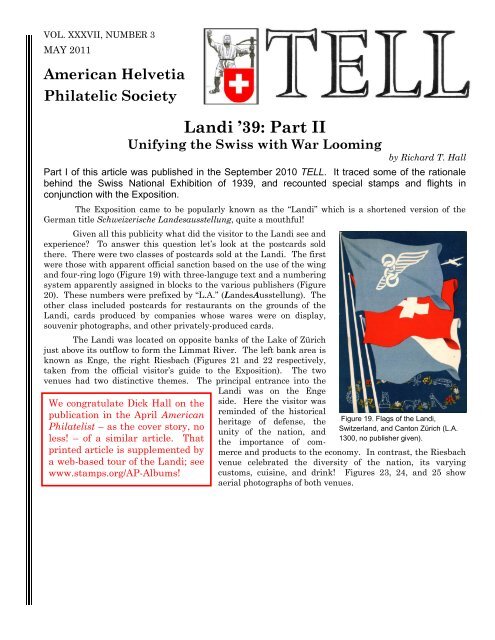Landi '39 - American Philatelic Society
Landi '39 - American Philatelic Society
Landi '39 - American Philatelic Society
Create successful ePaper yourself
Turn your PDF publications into a flip-book with our unique Google optimized e-Paper software.
VOL. XXXVII, NUMBER 3<br />
MAY 2011<br />
<strong>American</strong> Helvetia<br />
<strong>Philatelic</strong> <strong>Society</strong><br />
<strong>Landi</strong> ’39: Part II<br />
Unifying the Swiss with War Looming by Richard T. Hall<br />
Part I of this article was published in the September 2010 TELL. It traced some of the rationale<br />
behind the Swiss National Exhibition of 1939, and recounted special stamps and flights in<br />
conjunction with the Exposition.<br />
The Exposition came to be popularly known as the “<strong>Landi</strong>” which is a shortened version of the<br />
German title Schweizerische Landesausstellung, quite a mouthful!<br />
Given all this publicity what did the visitor to the <strong>Landi</strong> see and<br />
experience? To answer this question let’s look at the postcards sold<br />
there. There were two classes of postcards sold at the <strong>Landi</strong>. The first<br />
were those with apparent official sanction based on the use of the wing<br />
and four-ring logo (Figure 19) with three-languge text and a numbering<br />
system apparently assigned in blocks to the various publishers (Figure<br />
20). These numbers were prefixed by “L.A.” (LandesAusstellung). The<br />
other class included postcards for restaurants on the grounds of the<br />
<strong>Landi</strong>, cards produced by companies whose wares were on display,<br />
souvenir photographs, and other privately-produced cards.<br />
The <strong>Landi</strong> was located on opposite banks of the Lake of Zürich<br />
just above its outflow to form the Limmat River. The left bank area is<br />
known as Enge, the right Riesbach (Figures 21 and 22 respectively,<br />
taken from the official visitor’s guide to the Exposition). The two<br />
venues had two distinctive themes. The principal entrance into the<br />
<strong>Landi</strong> was on the Enge<br />
We congratulate Dick Hall on the<br />
publication in the April <strong>American</strong><br />
Philatelist – as the cover story, no<br />
less! – of a similar article. That<br />
printed article is supplemented by<br />
a web-based tour of the <strong>Landi</strong>; see<br />
www.stamps.org/AP-Albums!<br />
side. Here the visitor was<br />
reminded of the historical<br />
heritage of defense, the<br />
unity of the nation, and<br />
the importance of com-<br />
Figure 19. Flags of the <strong>Landi</strong>,<br />
Switzerland, and Canton Zürich (L.A.<br />
1300, no publisher given).<br />
merce and products to the economy. In contrast, the Riesbach<br />
venue celebrated the diversity of the nation, its varying<br />
customs, cuisine, and drink! Figures 23, 24, and 25 show<br />
aerial photographs of both venues.

















